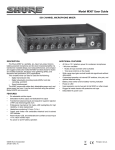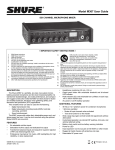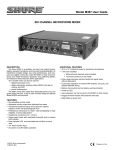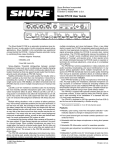Download Shure M367 User guide
Transcript
Model M367 AND M367E User Guide MODEL M367 AND M367E MICROPHONE MIXERS Professional mechanical VU meter—LED backlighting for high reliability, no lamp replacement Bi–color output LED shows output limiting and peak indication Output peak limiter with switchable threshold 1 kHz tone oscillator Mix bus jack to link M367s or other mixers Balanced Mix Bus connection to other M367s Monitor input via Phones push/pull control Headphones volume control 1/4” and 3.5 mm jacks for stereo headphones Customized operation via internal DIP switches, trim pots, and optional alternate wiring Regulated voltage rails (±15 Vdc) provide exceptional headroom Power-on LED Battery check switch and low battery warning indication AC power operating range from 100 to 120 volts, 50/60 Hz or 220–240 Vac, 50/60 Hz Soft-touch, color-coded control knobs with raised position indicators Rugged all metal chassis with protective end caps Detachable ac power cord Backup/field operation powering with two 9–volt batteries Automatically and silently switches to battery operation should ac voltage fail Designed and manufactured in U.S.A. with legendary Shure reliability and performance IF YOU’VE USED THE M267... Your new M367 mixer contains numerous features and improvements not found in the M267 model. If you don’t have the time or inclination to read this informative data sheet, these features are identified in the box below. You will then be familiar with the most important new capabilities of your M367. The Shure Model M367 is a six-input, portable microphone mixer/remote amplifier specifically designed for professional applications in electronic news gathering (ENG), electronic field production (EFP) and general audio mixing. It sets a new standard for portable mixer performance and features. Exceptionally low–noise design makes the M367 ideal for use with digital transmission links and digital video/audio recording media, including ISDN and DAT. Compact and rugged, the M367 is built to withstand the most demanding field production conditions. In addition, its excellent performance, versatility and features make it an ideal choice for studio, remote, or sound reinforcement use, and as an add-on mixer for expanding existing facilities. Each M367 handles up to six microphones or line-level signals. Any high-quality, low-impedance, balanced microphone using a dynamic or condenser* transducer (including wireless and shotgun types) can be used. Additional M367 or other Shure mixers can be linked using the rear–panel mix bus jacks. The M367 is supplied with rubber feet, detachable power cord, and spare power line fuse. Model A367R is an optional rack mount kit enabling the M367 to be mounted in a standard 483 mm (19–inch) audio equipment rack (two rack units). The M367 is supplied for operation at 100–120 Vac, 50/60 Hz, and the M367E for operation at 220–240 Vac, 50/60 Hz. Each model is internally switchable to the other’s operating voltage range. *Self-powered or operable on 12 or 48 Vdc phantom power. Features Exceptionally quiet design, suitable for use with DAT, recordable CD, and other digital formats Extended frequency response of 20 Hz to 20 kHz Dynamic range greater than 100 dB Transformer–balanced inputs and outputs for superior rejection of RFI and electromagnetic hum Six selectable mic/line inputs Selectable mic/line output and dedicated line output Metal XLR input and output connectors Wide–range input gain controls handle hot signal levels without attenuators 48 V or 12 V phantom power for condenser microphones Switchable low-cut filters on each input Peak indicator LED on each input 2000, Shure Incorporated 27A8511 (TG) • 12–, 48–volt phantom power • Input clipping LEDs • Detachable power cord • Two XLR outputs • Side battery compartment • Power–on LED • Headphones monitor circuit • Output peak/limiter LED • Selectable mix bus, balanced for M367s • Adjustable limiter threshold • Meter LED backlighting • VU lamp mode selector • Monitor input sensitivity selector • Program/monitor input selector 1 Printed in U.S.A. (6 dB below clipping). If the limiter is switched on, the LED illuminates green to indicate limiter operating threshold has been reached. The LED will still illuminate red if the preset peak level is reached before the limiter activation point is reached. 7. Battery Check Switch: When pressed, the status of the two 9V batteries is indicated on the VU meter: an indication in the red portion of the scale indicates adequate battery power. When the meter reads 0 VU, the batteries are at about 13.5 volts. A low battery condition is also indicated when the Power–On LED flashes. When using ac power (no batteries in compartment), the battery check gives no indication. FRONT PANEL CONTROLS AND INDICATORS (Figure 1) 1. Input Gain Control: Adjusts the gain level of each input channel. Rotating the knob counterclockwise reduces gain and raises the input clipping point. Use a low control setting to handle “hotter” input signals without distortion. With the new M367 input circuit, microphones with a “hot” output can be used without an in-line pad (attenuator). For best performance, adjust each Input Gain Control so the associated Input Peak LED illuminates red only on the loudest signal peaks. 1 kHz Tone Oscillator (Channel 1): Activated by pulling out Input Channel 1 Gain knob. Note: Tone level is adjusted using the Input 1 control and the Master control. Use this tone to send a reference signal level to any device connected to an M367 output. 2. Input Low-Cut Filter Switch: Provides low–frequency rolloff to reduce wind noise and rumble. When using the filter, the frequency response is down 7 dB at 150 Hz. Rolloff slope is 6 dB per octave. 3. Input Peak LED: Illuminates red if input signal reaches 6 dB below clipping (distortion). 4. Limiter Switch: Activates a fast–acting, peak–responding limiter. The limiter helps prevent overload distortion from unexpected loud input signals. Limiter action is indicated by the Output Peak/Limiter LED, which will illuminate green. The 0.1-second release time is optimized for speech signals; an internal modification can provide a 1-second release time for music signals (see Internal Modifiable Functions). 5. Output Level Meter: The illuminated mechanical VU meter provides reliable operation and excellent visibility in all environmental and ambient lighting conditions.The meter response approximates true VU characteristics (about 300 ms rise and fall, 1% to 5 % overshoot). If a slower response is desired, see Internal Modifiable Functions. 0 VU is switchable between +4 and +8 dBm output level by an externally accessible switch (see Internal Switches and Controls). An LED array illuminates the meter, eliminating lamp replacement. The meter is illuminated at all times when the mixer is ac–powered. With dc power, the meter illumination is activated by the Batt Check switch. 6. Output Peak/Limiter Bi–Color LED: Illuminates red when output signal reaches a factory preset peak level of +12 dBm 2 3 When the M367 is battery–powered and the switch is pressed momentarily, the meter illumination turns on for about 10 seconds. Changing meter illumination action to toggled (meter illumination stays on until the switch is pressed again) can be accomplished via internal DIP switch 6 (see Internal Switches and Controls for instructions). Note: The audio signal is not interrupted when the Battery Check switch is pressed. 8. Power–On/Off Switch: Turns the mixer on and off. 9. Power–On LED: Illuminates green to indicate power is on. Flashes to indicate low batteries, typically when about 30 minutes of operation remains. 10. Headphones Gain Control: Rotates to adjust headphones volume level. WARNING The headphones circuit is capable of producing high volume levels that can damage the user’s hearing. Make sure headphone volume setting is low (full CCW) before putting headphones on. Pull/Monitor Switch: When knob is pulled outward, audio signal from Monitor In jack is sent to headphones output, interrupting the program signal to the headphones. If an attenuated program signal with the monitor signal is desired, refer to the Internal Switches and Controls section. 11. Headphones Outputs: Stereo 1/4–inch phone jack and stereo 3.5 mm miniature phone jack may be used separately, simultaneously, or as auxiliary feeds to other equipment. 12. Master Gain Control: Sets mixer output gain. Set to 0 dB position for unity gain output stage. 4 6 5 7 8 9 ÁÁÁ ÁÁÁÁÁÁÁÁÁÁÁÁÁÁÁÁÁÁÁÁÁÁÁÁÁÁÁÁÁÁÁÁ Á ÁÁÁÁÁÁÁÁÁÁÁÁÁÁÁÁÁÁÁ ÁÁ Á ÁÁ ÁÁ ÁÁ Á ÁÁ Á Á Á Á Á ÁÁÁ Á ÁÁÁÁÁÁÁ ÁÁ Á ÁÁ Á ÁÁÁÁÁÁÁÁÁ ÁÁ ÁÁÁÁÁÁÁÁ Á ÁÁ Á ÁÁÁÁÁÁÁÁÁÁÁÁÁÁÁÁÁÁÁÁÁÁÁÁ ÁÁ ÁÁ Á ÁÁ Á ÁÁ ÁÁ Á Á ÁÁ ÁÁÁÁÁÁÁÁÁÁÁ Á Á Á Á Á Á Á Á Á Á Á Á Á ÁÁ Á Á ÁÁ Á Á Á Á Á Á Á Á Á Á ÂÂÂÂÂ ÂÂ Á ÁÁÁÁÁÁÁÁ Á Á Á Á Á Á Á ÁÁ Á Á Á ÁÁ Á Á Á ÁÁ Á Á Á ÁÁ Á Á Á Á Á Á Á ÁÁ Á Á Á Á Á Á ÁÁÁÁÁÁ Á Á Á Á ÁÁÁÁÁÁÁÁÁÁÁÁÁÁÁÁÁÁÁÁÁÁÁÁÁÁÁÁÁÁÁÁÁÁÁ ÁÁÁÁÁÁÁÁÁÁÁÁÁÁÁÁÁÁÁ Á Á Á Á ÁÁ Á ÁÁÁÁÁÁÁÁÁÁÁÁ Á PEAK PEAK PEAK PEAK PEAK PEAK LIMITER OUT 5 5 7 3 0 7 3 0 1 10 PULL/1KHz 5 2 10 5 7 3 0 3 10 5 7 3 0 4 10 0 5 10 IN 5 7 3 POWER 7-20 3 0 6 10 1 VU 0 +12 MASTER M367 12 FRONT PANEL CONTROLS AND INDICATORS FIGURE 1 2 BATT PEAK CHECK ON PHONES PULL/MONITOR 11 10 1 2 3 4 ÁÁÁÁÁÁÁÁÁÁÁÁÁÁÁÁÁÁÁÁÁÁÁÁÁÁÁÁÁÁÁÁÁÁÁ ÁÁ Á ÁÁÁÁÁÁ ÁÁ ÁÁ Á Á ÁÁÁ Á ÁÁÁÁÁ ÁÁÁ Á Á ÁÁ Á ÁÁ Á Á ÁÁÁ ÁÁ Á Á ÁÁÁÁ ÁÁÁ Á Á ÁÁÁ Á Á ÁÁÁ Á Á ÁÁ Á Á Á Á Á Á ÁÁÁÁ ÁÁ ÁÁ ÁÁ ÁÁÁÁ ÁÁÁÁÁÁÁ ÁÁÁÁ ÁÁ Á Á Á ÁÁÁÁÁÁÁÁ Á Á Á Á Á Á Á ÁÁÁÁÁÁÁÁÁ ÁÁÁ ÁÁ Á ÁÁÁÁÁÁÁÁÁÁÁÁÁÁÁÁÁÁÁÁÁÁÁÁÁÁÁÁÁÁÁÁÁÁ ÁÁ ÁÁ Á Á ÁÁÁÁÁÁÁÁ Á MIC LINE PHANTOM MIC LINE 100/120 VAC 50/60 Hz 100 mA OFF LINE SPARE LINE MIC LINE MIC LINE MIC LINE MIC LINE LEVEL M267 M367 ON MONITOR IN 6 OUTPUT 9 MIC 8 5 4 INPUT 7 3 2 1 6 REAR PANEL CONNECTORS AND CONTROLS FIGURE 2 REAR PANEL CONNECTORS AND CONTROLS (Figure 2) 1. Mic/Line Level Output Switch: Selects Mic or Line level to match proper input level of the device connected to the M367 output. Mic signal level is typically 0.0001 – 0.003 V; Line signal level is typically 0.1 – 3.0 V. TO M367 #1 MIX BUS 5 BALANCED ÄÄ ÄÄ ÄÄ TO M367 #2 UNBALANCED 2. Phantom Power Switch: Activates 12–volt phantom power on each input set to Mic Level input. If needed, 48–volt phantom power is available through activation of internal DIP switch No. 7 (see Internal Switches and Controls for instructions). Note: Balanced dynamic microphones will not be damaged by phantom power. TO M367 N.C. TO M267 MIX BUS CONNECTIONS FIGURE 3 6. Channel Inputs: Six female XLR inputs are transformer–balanced to provide superior rejection of hum, RFI, and other interference. 7. Monitor In Jack: Designed to accept line level signals. This mono jack (tip—signal, sleeve—ground) provides a “tape return” input or a communications channel input. The signal appears only in the M367 headphones circuit. Pulling the Phones gain control (Pull/Monitor switch) routes the Monitor In signal to the headphones. The M367 audio is not heard in the headphones when the Monitor In switch is activated. M367 program signal mixed with the Monitor In signal can be accomplished via internal DIP switch 4 (see Internal Switches and Controls for instructions). The Monitor In jack can be modified to accept a stereo input and provide a stereo sum monitor signal (see Internal Modifiable Functions section). 8. Mixer Output: Two male XLR outputs are transformer–balanced. The Line output is preset to line level (the line level output can be modified to a true 600 Ω output impedance or changed to mic level if desired [see Internal Modifiable Functions section]). The switchable output may be either microphone or line level. 9. 100/120 VAC, 50/60 Hz Power Connector (M367): The three–pin power connector provides for connection of the supplied power cord to 100 to 120 Vac, 50/60 Hz power outlets. 220/240 VAC, 50/60 Hz Power Connector (M367E): The three–pin power connector provides for connection of the supplied power cord to 220 to 240 Vac, 50/60 Hz power outlets. .125A, 250V Time Delay Fuse (M367): Directly below the power connector is a slide–out compartment containing two power line fuses. The outer (toward you) fuse is a spare. .063A, 250V Time Delay Fuse (M367E): Directly below the power connector is a slide–out compartment containing two power line fuses. The outer (toward you) fuse is a spare. 3. Mic/Line Level Input Switches 1–6: Selects Mic or Line to match the incoming signal level. Mic signal level is typically 0.0001 to 0 .003 volts and Line signal level is typically 0.1 to 3.0 volts. In the Line level position, phantom power is disconnected from the inputs. 4. M267/M367 Mix Bus Level Switch: Selects a matching mix bus level for the mixer connected to the M367. The M267 position is used when a Shure M267 (or Shure FP42, FP51, M67 or SE30) is connected; the M367 position is used when another M367 (or Shure FP32A) is connected to the Mix Bus. IMPORTANT In the M267 position, mixer output noise may increase up to 30 dB, depending on the Master output control setting. Unless required for mix bus hookup with an M267 or similar mixer, leave the Mix Bus Level switch in the M367 position. 5. Mix Bus Jack: Allows two mixers to be connected together. The Mix Bus connection is “two–way” and pre–Master. When two M367 mixers are connected via the Mix Bus, all 12 inputs appear at both mixers’ outputs. The Master Gain control of either M367 can be adjusted without affecting the other mixer’s output. This provides the equivalent of a 12–input mixer with two separate Master output sections. NOTE: The output level of both M367 mixers will drop by 6 dB when they are connected via the Mix Bus. Increase the Master Gain to compensate. The M367 has a balanced mix bus for optimum performance when connected to another M367. Use a mix bus cable with two 1/4–inch stereo (tip, ring, sleeve) plugs for this application. For mix bus connection to another Shure mixer, construct a mix bus cable with a 1/4–inch mono phone plug (tip—signal, sleeve—ground) and the appropriate connector for the other mixer’s mix bus jack (see Figure 3). 3 NOTE: This unit is not disconnected from the mains supply when the Power switch is off. Remove the power connector from the ac source when the mixer is not in use. (MIXER SIDE VIEW) BATTERY COMPARTMENT (right side of mixer) 1. Battery Compartment: Holds two 9–volt batteries. Two fresh 9–volt alkaline batteries will power the unit for at least eight hours under normal conditions. The battery compartment is withdrawn by grasping the sides of the compartment, squeezing to release the locks, and pulling the compartment outward. 2 1 2 3 4 5 6 7 BATTERY COMPARTMENT 1 INTERNAL DIP SWITCHES FIGURE 4 With batteries in the battery compartment, the M367 will automatically and silently switch to battery operation should the ac voltage fall below a suitable level. DIP SWITCH S701 FUNCTIONS ABOUT BATTERY LIFE... The M367 is designed for low current consumption. Under typical (+4 dBm into 600 Ω in continuous use; no phantom–powered microphones, meter illumination or headphones in use) and with two fresh 9–volt alkaline batteries, the M367 will operate for about eight hours before the Power LED flashes. At this point, about 30 minutes of battery life remains. If more mixer features are used (Phantom–powered microphones, continuous headphones monitoring, or constant meter illumination), battery life will decrease accordingly (see table). Mixer Operation DIP SWITCH S701 Switch Position Switch Function Switch Up Switch Down 1 Meter 0 VU 0 VU = +4 dBm 0 VU = +8 dBm 2 Limiter 2 Up + 3 Up = +16 dBm 2 Down + 3 Up = +8 dBm 3 Threshold 4 Program to Monitor Off On (provides attenuated program signal in headphones with Pull/ Monitor switch on [pulled outward]) 2 Up + 3 Down = +4 dBm 2 Down + 3 Down = 0 dBm Battery Current (mA) Battery Life (hours)* (A) No signal, phantom–powered mics, headphones or meter illumination 40 9 5 Monitor In Gain Normal High (B) As in (A) with +4 dBm continuous output 45 8 6 VU Lamp (C) As in (B) with six Shure SM81 mics at 12 V phantom power 55 6.5 (D) As in (B) with six Shure SM81 mics at 48 V phantom power 70 5 Toggled (turns on/ off when front panel Batt Check switch is toggled. Automatic timed turnoff of lamp will not occur.) (E) As in (B) with 300 Ω headphones driven moderately loud (Phones control at “5”) 50 7 Timed (turns on/off when front panel Batt Check switch is activated. If not manually switched off, lamp will automatically turn off after 10 seconds to conserve battery life.) (F) As in (B) with meter illumination continuously on (DIP switch position 6 closed and Batt Check switch pressed once) 75 4.5 7 Phantom Power 12 Vdc phantom power to all input channels if selected and rear– panel Phantom switch is on. 48 Vdc phantom power to all input channels if selected and rear– panel Phantom switch is on. *until Power LED begins to flash, allowing about 30 minutes to replace batteries. Momentary use of headphones or meter illumination will not appreciably affect battery life. M367 SETUP To prepare the M367 mixer for operation, proceed as follows: NOTE: The M367 draws insignificant current (6 µA) from the batteries when the mixer is turned off and batteries are installed. Batteries left in the M367 will retain their charge up to their shelf life.However, long–term storage of batteries in the M367 is not recommended. 1. For ac operation, attach the supplied power cord to the rear– panel ac connector and to a 100 to 120 Vac, 50/60 Hz grounded (3–pin) power source. If desired, select functional options by removing the battery compartment and activating the exposed DIP switches (condenser microphone power, limiter threshold, etc.). Reinsert and secure the battery compartment. INTERNAL SWITCHES AND CONTROLS (Figure 4) The M367 contains internal switches and adjustments that are accessed through removal of the battery compartment and top cover. These functions are described in the following paragraphs. 2. For internal battery operation, remove the battery compartment. Install two 9 V alkaline batteries, making sure polarity (+/–) is correct (batteries will not seat correctly unless polarity is correct). Select functional options using the DIP switches (condenser microphone power, limiter threshold, etc.) Reinsert and secure the battery compartment. 2. Battery Compartment DIP Switches S701: Remove the battery compartment. This exposes the DIP switch assembly. The switches provide the options in the following table (“up” is the switch–open position; position shown in bold type is factory setting). NOTE: The VU meter is illuminated during ac operation. To illuminate the VU meter during battery operation, press the front– panel Batt Check switch: If the internal VU Meter DIP switch is in the factory–set Timed position, the VU meter will illuminate for 10 seconds and then turn off. If the switch has been set to the Toggled position, the meter will illuminate after pressing the Batt Check switch and remain on until the Batt Check switch is NOTE: Switch positions and effects are also shown on the label on the mixer cover. 4 pressed again. (Note that this mode will drain batteries faster than the Timed mode.) WARNING The headphones circuit is capable of producing high volume levels that can damage the user’s hearing. Make sure the headphones volume setting is low (full CCW) before putting the headphones on. 3. If greater clearance for the Input Channel 1 Gain knob is desired, the left end cap can be removed, rotated 180°, and replaced. Note that in this configuration, the end cap will not protect the gain knobs if the mixer is dropped. 9. Adjust the Input gain controls based on the incoming signal levels. The Input Peak LEDs should flicker red only on loud input peaks. 4. Connect microphones, wireless microphone receivers, or other audio sources to the desired Input channel connectors on the rear panel. 10. Observe the output on the VU meter and adjust the Master gain to obtain the desired levels. Try to keep the average levels around “0 VU”. The Peak LED adjacent to the VU meter should illuminate only on loud output peaks. 5. Position each Mic/Line Input switch based on the level of the incoming source. 6. Connect the amplifiers, camcorders, DAT machines, wireless microphone transmitters, or other equipment to the Output XLR connectors on the rear panel. The M367 mixer is now ready for use. Connecting M367 Outputs to Telephone Lines In the Line position, the transformer–balanced XLR outputs can be used to drive dc–biased, “dialed up” telephone lines, although there may be a slight increase in distortion. Use of the M367 limiter circuit is strongly advised with the limiter threshold set to +4 dBm. Modification of the M367 output impedance to 600 Ω is recommended for proper fidelity. (See the Internal Modifiable Functions section for instructions.) When connecting the M367 to a telephone line, an FCC–Registered interface adapter between the mixer and telephone line is mandatory. 7. Position the Mic/Line Output switch based on the input level requirements of the equipment connected to the switched M367 output (the other output is Line Level only). 8. If a “tape return” or Monitor In feed into the M367 is required, connect a phone plug to the rear–panel Monitor In connector. The signal on this connector typically comes from the audio output of the device being fed by the M367. 9. Plug headphones into the stereo 1/4 in. or 3.5 mm mini Phones jacks on the right side of the front panel. SUPPLIED ACCESSORIES AND REPLACEMENT PARTS Foot Kit (4 in kit) . . . . . . . . . . . . . . . . . . . . . . . . . . . . . . . 90S8100 Fuse, 0.125 A, 250 V, Time Delay (M367) . . . . . . . . . . 80E380 Fuse, 0.063 A, 250 V, Time Delay (M367E) . . . . . . . . . 80G380 Knob, Master . . . . . . . . . . . . . . . . . . . . . . . . . . . . . . . . . 95A8238 Knob, Channel Gain, Phones . . . . . . . . . . . . . . . . . . . . 95B8238 Line (Power) Cord, (M367) . . . . . . . . . . . . . . . . . . . . . . 95A8389 Line (Power) Cord, (M367E) . . . . . . . . . . . . . . . . . . . . . 95B8389 NOTE: The two Phones output connectors may be used separately, simultaneously, or as auxiliary feeds to other equipment. 10. To interconnect two M367 or other Shure mixers, plug a singleshielded mix bus cable into the Mix Bus connectors of both mixers (Figure 3). OPTIONAL ACCESSORY Rack Mount Kit . . . . . . . . . . . . . . . . . . . . . . . . . . . . . . . . . . A367R NOTE: When two M367 mixers are interconnected via the Mix Bus, the Master gain on either mixer can be adjusted without affecting the other mixer’s output level. This provides the equivalent of a 12–input mixer with two separate Master output sections. SPECIFICATIONS Measurement conditions (unless otherwise specified): operating voltage 120 Vac, 60 Hz (18 ±1 Vdc for dc test); operating temperature 22°C (72°F); input signal 1 kHz; internal DIP switches 1–7 open; Power switch on; Mic/Line switches to Line; low–cut switches to flat; Limiter out; Phantom power off; Mix Bus to M367; channel 1 gain full CW; channel 2 through 6 full CCW; Master full CW; Phones level full CCW; Line output terminations 600 Ω (pins 2 and 3); Mic output terminations 150 Ω (pins 2 and 3); Phones (1/4 ”—ring) 300 Ω to ground; Phones (1/4 ”— tip) 300 Ω to ground; Phones (3.5 mm) unloaded; Mix Bus 930 Ω (M367 position)or 3.5 kΩ (M267 position), not connected unless specified; 1 kHz input signal. 11. Set the Master gain, Phones volume, and all Input gains fully counterclockwise (off). OPERATION To operate the M367 microphone mixer, proceed as follows: 1. Apply power to the mixer by sliding the On/Off switch to the right. The green Power LED will illuminate to indicate that the mixer is turned on. 2. Check the mixer battery power status by depressing the front– panel Battery Check switch. The VU meter needle will swing between 0 and +3 VU. If the needle falls below 0 VU, less than 30 minutes of battery power operation remain. Frequency Response 20 to 20,000 Hz ± 2.0 dB (channel controls centered) Total Harmonic Distortion 0.25% THD at +4 dBm output, 55 to 20,000 Hz 3. Push the front–panel Phones knob inward to route the M367 audio to the headphones. Voltage Gain 4. Slide the Limiter slide switch to the On position to protect against output overload. Output Input Line Mic Phones Mix Bus (M367) Mix Bus (M267) Low–Z Mic (150 Ω) 87 dB 40 dB 103 dB 66 dB 27 dB 5. Position the Low–Cut Filter slide switches for each Input: UP for flat; DOWN for low–cut on. 6. Set the Master Gain knob to the “0 dB” position (2 o’clock). This provides unity gain for output stages. 7. Activate the 1 kHz tone oscillator by pulling the Input 1 gain knob outward. Adjust the Input 1 gain until the VU meter needle indicates “0”. Adjust the input levels on the equipment connected to the M367 outputs accordingly. Push in the Input 1 knob to turn off the tone. 8. Put on headphones and carefully adjust Phones volume control to a comfortable listening level. 5 Line 37 dB –11 dB 53 dB 15 dB –25 dB Monitor –– –– 12 dB –– –– Mix Bus (M367) 10 dB –38 dB 26 dB –– –– Mix Bus (M267) 50 dB 2 dB 66 dB –– –– Phantom Power 12 V Phantom: 12 V through 340 Ω 48 V Phantom : 48 V through 3.4 kΩ Inputs Input IMPEDANCE Designed Actual for Use With (Internal) Input Clipping Level Mic 19 to 600 Ω 1 kΩ –10 dBV +36 dBV Line ≤10 kΩ 50 kΩ Monitor ≤1 kΩ 13 kΩ 0 dBV Mix Bus (M367) 930 Ω bal.; 1860 Ω unbal. 930 Ω bal.; 1860 Ω unbal. +23 dBV Mix Bus (M267) 3.5 kΩ 3.5 kΩ –17 dBV Mixer Power AC. M367: 100–120 Vac, 50/60 Hz, 100 mA (can be rewired for 220–240 Vac operation); M367E: 220–240 Vac, 50/60 Hz, 50 mA (can be rewired for 100–120 Vac operation); no–signal current drain 25 mA DC; meter illumination off. 18 Vdc nominal at 40 mA typical no–signal, 45 mA typical at +4 dBm output; 13.5 Vdc minimum; battery life approximately 8 hours at +4 dBm output in continuous use.* *Meter not illuminated; no phantom microphones; no headphones. Outputs Output Mic IMPEDANCE Designed Actual for Use With (Internal) DC; meter illumination on. 18 Vdc nominal at 70 mA typical no–signal, 75 mA typical at +4 dBm output; 13.5 Vdc minimum; battery life approximately 4 hours at +4 dBm output in continuous use. Batteries. Two 9 V alkaline batteries, type NEDA 1604A (Duracell MN1604 or Eveready 522 recommended) Temperature Range Operating: –18° to 57° C (0° to 135° F) Storage: –29° to 74° C (–20° to 165° F) Output Clipping Level Low–Z inputs 1Ω –31 dBV Line 600 Ω 150 Ω +18 dBm Phones 8 to 200 Ω 300 Ω +11 dBV Mix Bus (M367) 930 Ω bal.; 1860 Ω unbal. 930 Ω bal.; 1860 Ω unbal. +11 dBV Mix Bus (M267) 3.5 kΩ 3.5 kΩ –28 dBV Overall Dimensions (H x W x D) 71.9 mm x 308 mm x 233 mm (213/16” x 125/32” x 95/32”) including feet Weight (without batteries) 3 kg (6.6 lb) Equivalent Input Noise ≤ –127 dBV with 150 Ω source, 400 to 20,000 Hz Output Noise Master level full CCW: –100 dBV, 400 to 20,000 Hz Master level full CW: –80 dBV, 400 to 20,000 Hz Hum and Noise Equivalent Input: ≤125 dBV, 20 to 20,000 Hz Output: –95 dBV (Master CCW); –75 dBV (Master CW), 20 to 20,000 Hz Common Mode Rejection Ratio 65 dB at 100 Hz, –20 dBV input Polarity Mic/Line In to Mic/Line Out Non–Inverting Mic/Line In to Phones Non–Inverting Mic/Line In to Mix Bus (tip) Inverting Monitor to Phones Non–Inverting Mix Bus to Mic/Line Out Inverting STATEMENT OF CONFORMITY This certifies that the Shure M367E Microphone Mixer meets the specifications and regulations embodied in Vfg 243/1991, amended 1992. The Bundesamt für Zulassungen in der Telekommunikation has been notified that this device has been marketed and has been provided the right to verify the device or system for compliance with the specifications. Conforms to European Union directives, eligible to bear CE marking; VDE GS-Certified to EN 60 950; meets European Union EMC Immunity Requirements (EN 50 082–1, 1992): RF radiated (IEC 801–3): meets Criterion A, ESD: meets Criterion B, EFT (IEC 801–4): meets Criterion B INFORMATION TO USER Changes or modifications not expressly approved by Shure Brothers Inc. could void your authority to operate this equipment. This equipment has been tested and found to comply with the limits for a Class B digital device pursuant to Part 15 of the FCC Rules and as set out in the Radio Interference Regulations of the Canadian Department of Communications. These limits are designed to provide reasonable protection against harmful interference in a residential installation. This equipment generates, uses, and can radiate radio frequency energy and, if not installed and used in accordance with the instructions, may cause harmful interference to radio communications. However, there is no guarantee that interference will not occur in a particular installation. If this equipment does cause harmful interference to radio or television reception, which can be determined by turning the equipment off and on, the user is encouraged to try to correct the interference by one or more of the following measures: 1. Reorient or relocate the receiving antenna. Overload and Shorting Shorted outputs, even for prolonged periods, cause no damage. Microphone inputs of up to 3 Vrms cause no damage. Line and monitor can withstand signals of up to 30 Vrms. Input Peak Indicators 6 dB below clipping level Output Peak Indicator Lights red at 6 dB below clipping level Output Clipping Level ≥ +18 dBm at line output into 600 Ω Low–Cut Filters 7 dB down at 150 Hz; 6 dB/octave slope (3 dB down at 260 Hz) Tone Oscillator 1 kHz ± 20% Limiter Threshold: Switchable: 0, +4, +8, +16 dBm Attack Time: 1 ms ± 0.5 ms Release Time Constant: 100 ms ± 30 ms Indicator: Green when limiting by 1 dB or more 2. Increase the separation between the equipment and receiver. 3. Connect the equipment into an outlet on a circuit different from that to which the receiver is connected. 4. Consult the dealer or an experienced radio/TV technician for help. 6 INTERNAL ADJUSTMENTS WARNING All internal modifications must be performed by qualified service technicians. WARNING All internal adjustments must be performed by qualified service technicians. Disassembling the M367 1. Remove the mixer top cover as described above. NOTE: All internal adjustments require only removal of the top cover. 1. Remove battery compartment. 2. Carefully remove three multi–pin cable assembly connectors from upper front PC board (nearest front panel).Remove three Phillips head screws which secure PC board. Remove upper front PC board. 2. Remove four screws securing two plastic end caps and one ground–bonding screw on the side opposite the battery compartment. 3. Carefully remove four multi–pin cable assembly connectors from upper rear PC board (nearest rear panel).Remove three Phillips head screws which secure PC board. Remove upper rear PC board. 3. Slowly slide cover up and off chassis. VCA Distortion Factory Preset Potentiometer R607 (see Figure 5) DO NOT ADJUST! This potentiometer is precisely calibrated on each mixer for minimum distortion. 4. Perform modification (refer to appropriate procedure below). Note that all modifications can be performed without removing the main PC board. VU Meter Adjustment (see Figure 5) This trimpot adjusts the VU meter to indicate 0 VU at a preset output level. The factory setting is +4 dBm. The user adjustment range is –10 dBV to +4 dBm (–6 dBV to +8 dBm with DIP switch 1 down. 5. Reassemble M367 by performing above steps in reverse, assembling the Phillips screws in the order indicated on the upper front and upper rear PC boards. Changing Operating Voltage Range The M367 and M367E can be internally modified for an alternate operating range. M367 Operation at 220–240 Vac 1. Disconnect the ac power and remove the mixer top cover as described above. VU METER CALIBRATION TRIMPOT R684 2. Locate Voltage Selector switch S301 adjacent to power transformer T301. Use a screwdriver to move the center dial so “230” is opposite the indicator. Replace the top cover. VCA DISTORTION TRIMPOT R607 3. Open the rear–panel fuse compartment and replace the 0.125 mA, 250 V fuses (operating and spare) with 0.063 mA, 250 V fuses of the same size and type. Close the fuse compartment. M367E Operation at 100–120 Vac (ACCESSED THROUGH HOLE IN UPPER FRONT PC BOARD) 1. Disconnect the ac power and remove the mixer top cover as described above. 2. Locate Voltage Selector switch S301 adjacent to power transformer T301. Use a screwdriver to move the center dial so “115” is opposite the indicator. Replace the top cover. DIP SWITCH S701 3. Open the rear–panel fuse compartment and replace the 0.063 mA, 250 V fuses (operating and spare) with 0.125 mA, 250 V fuses of the same size and type. Close the fuse compartment. INTERNAL ADJUSTMENTS FIGURE 5 To set the VU meter to a value other than the factory setting (0 VU = +4 dBm), proceed as follows: Changing Line Level Output Impedance to 600Ω 1. Locate resistor R621 (near IC U602 pin 8) on main PC board and remove it. 1. Connect a 600 Ω load to an XLR output set for Line. 2. Locate empty pads X621 (near resistor R621). 2. Connect an ac voltmeter with 1 MΩ or greater input impedance (Fluke 77 or equivalent) in parallel with the load. 3. Solder a 430 Ω, 1/2W resistor through the holes at X621. 3. Pull out the channel 1 Gain knob to activate the 1 kHz tone oscillator. Changing Unswitched Line Output to Mic Level 1. Locate resistor R632 (near output transformer T601) and remove. 4. Adjust the 1 kHz tone oscillator level with the Master gain control until the ac voltmeter reading is at the level desired. 2. Locate empty pads X632 (near transformer T601). 3. Solder a jumper wire through the holes of X632. 5. With the M367 top cover removed, adjust the VU Level Calibration trim pot R684 with a screwdriver until the VU Meter reads 0. Changing Mixer Audio Levels in Headphones (Pull/Monitor Switch Activated, DIP Switch S701 Position 4 Closed) 1. Locate empty pads X649 (near Phones potentiometer R648). 6. For 0 VU settings between +4 and +8 dBm, set internal DIP switch S701 position 1 “down”, and perform steps 1 through 5. 2. Solder a 68 kΩ, 1/4 W resistor through the holes at X649 to hear program audio 12 dB down from standard headphones level with Pull/Monitor switch on (pulled out). INTERNAL MODIFIABLE FUNCTIONS Selected internal functions of the M367 can be modified by the user to fit special applications. All modifications are performed through solder points accessible on the main PC board. Procedures for performing these modifications are listed below. 3. Solder a 24 kΩ, 1/4 W resistor through the holes at X649 to hear program audio 6 dB from standard headphones level with Pull/ Monitor switch on (pulled out). 7 Changing Low–Cut Filter Corner Frequency (3 dB down point) A. To decrease corner frequency: 1. Calculate new capacitor value for lower low–cut corner frequency. Use the following formula: Adapting Line Out to Dual Banana Jack Adding a dual banana jack, balanced, line–level output capability can be accomplished by purchasing a commercial unit (Sescom XLR F–3BP or equivalent), or obtaining a female XLR connector (Radio Shack 274–011 or equivalent), a dual banana jack (ITT 2269 or equivalent), a small utility box, and a short length of high–quality shielded output cable and constructing the adapter shown in Figure 6. C in µF= (85/frequency) – 0.33 Example: for 200 Hz corner frequency, 85/200 ≈ 0.43 0.43 – 0.33 = 0.1 For 200 Hz corner frequency, use a 0.1 µF capacitor. Note: Capacitor must be non–polarized; ceramic or film type; 16V rating or higher. 2. Locate the following empty pads: Pad Channel Pad Channel X421 1 X451 4 X431 2 X521 5 X441 3 X531 6 1 2 3 Ë ËË ÁÁ ËË Ë ÁÁ ËË ÁÁË DUAL BANANA JACK OUTPUT FIGURE 6 Connect this adapter to the M367 Line output. All pads are found near ribbon cable assemblies W811, W812 and W813. 3. Solder a new capacitor through the holes of the empty pads for each channel to be modified. B. To increase corner frequency: Note: Low–cut corner frequencies much higher than the factory preset of 260 Hz may excessively attenuate desired low– to mid–frequency program material. 1. Locate the following capacitors near empty pads: Capacitor Pad Channel Capacitor Pad Channel C425 X421 1 C455 X451 4 C435 X431 2 C525 X521 5 C445 X441 3 C535 X531 6 Changing Monitor In to Aux In Note: This modification will disable the M367’s monitor function. 1. Locate and remove resistors R642 and R647 (near Phones potentiometer R648). 2. Locate empty pads X601 (near output transformer T601) and X643 (near Monitor In jack J683). 3. Solder a jumper wire from X643 to X601. The Monitor In jack is now an unbalanced (tip positive, sleeve ground) Aux In jack, with an input impedance of 11 kΩ and a maximum gain to Line Out (loaded with 600 Ω) of 17 dB. The Aux In signal is only controlled by the Master control. 4. To change Aux In gain, locate resistor R605 (near X601). Carefully remove R605 and replace it with a surface–mount resistor (0805 package) of the desired value. If R605 is replaced with 15 kΩ, maximum Aux In to Line Out gain will be 14 dB and input impedance will be 16 kΩ; if it is replaced with 6.8 kΩ, maximum Aux In to Line Out gain will be 20 dB and input impedance will be 7.8 kΩ. Changing Monitor In High Gain (DIP Switch S701 Position 5 Down) 1. Locate resistor R647 (near Phones potentiometer R648) and remove it. 2. Locate empty pads X647 (near R647). 2. Remove the indicated capacitor for each channel to be modified. 3. Calculate new capacitor value for higher high–cut corner frequency. Use the following formula: C in µF= (85/frequency) Example: for 400 Hz corner frequency, C = (85/400) = 0.21 For 400 Hz corner frequency, use a 0.22 µF capacitor. 4. Solder a new capacitor through the holes of the empty pads for each channel to be modified. Slowing Output Level Meter from “True VU” Ballistics 1. Locate empty pads X691 (at left of VU meter M1). 2. Solder a 100 µF x 6.3 V electrolytic capacitor through the holes of X691. Observe capacitor polarity as marked on the PC board. The response time is now 500 ms with no overshoot. 3. To slow the meter response even further, use a larger capacitor value. Changing Mic Level Output Impedance 1. Locate resistor R631 (near output transformer T601) and remove it. 2. Locate empty pads X631 (near T601). 3. Solder desired value 1/4 W resistor through the holes of X631. For example, use a 150 Ω, 1/4 W resistor for 150 Ω output impedance. 3. Solder a 330 Ω, 1/4 W resistor in the holes of X647 for 6 dB gain boost with DIP switch S701 position 5 down (input impedance will be 6.5 kΩ in this position). Changing Monitor In Jack from Mono Input to Stereo Sum Input 1. Locate empty pads X645 (near Monitor In jack J863). 2. Solder a 1 kΩ, 1%, 1/4 W resistor in the holes of X645. The Monitor In jack will now accept a stereo input signal (tip left, ring right, sleeve ground), and sum these signals to the monitor circuit. Note: If a true stereo feed is used to drive the M367 Monitor In and another stereo device, the source impedance must be 20 Ω or less to maintain at least 40 dB separation in the stereo device. Use a stereo distribution amplifier or buffer to maintain optimum stereo separation. 8 Master Gain Remote Control Note: This modification will disable both the M367’s monitor function and its front–panel Master gain control, 1. Locate resistor R641 (near Monitor In jack J863) and remove it. 2. Locate resistor R746 (near Master potentiometer R706) and remove it. 3. Locate empty pad X702 (near Master potentiometer R706). Solder one end of a 100 Ω, 1/4 W resistor in the hole of X702. Solder an insulated wire to the other end of the 100 Ω resistor. Locate empty pad X644 (near jack J863). Solder the other end of the insulated wire to X644. 4. Locate empty pad X701 (next to empty pad X702). Solder an insulated wire to X701. Locate empty pads X645 (near jack J863). Solder the other end of the insulated wire to the empty pad X645 nearest channel 6 input connector J856. 5. Construct a remote control potentiometer/cable assembly as shown in Figure 7. DIP Switch S701 Limiter Threshold Position 2 Position 3 Requiv (above) — dBm — up up high _____ _____kΩ = R1 down up med. high _____ _____kΩ = R2 up down med. low _____ _____kΩ = R3 down down low _____ _____kΩ = R4 2. Locate resistors R721, R731, R732, R733, R734 and R735 (surrounding IC U704) and remove them. 3. Locate empty pads X732, X733, X734 and X735 (surrounding IC U704). 4. Select a 1/4 W, 1% resistor closest in value to R1 (from the worksheet), and solder it to the holes of X732. Note: Use parallel or series combinations of resistors to match the chosen values as closely as possible if 1% resistors are not available. 5. Calculate resistor R5 value as follows: TIP 1 R5 = 1 R2 RING CW MASTER GAIN REMOTE CONTROL FIGURE 7 Recommended parts are: Potentiometer, 10–25 kΩ, linear taper (Radio Shack 271–1715) 1/ –Inch Stereo Phone Plug (Switchcraft 280) 4 Ferrite Bead Rings (Ferronics 21–031J) Capacitors, ceramic, 0.001 µF, 50 V Cable, 2–conductor, shielded, 50 ft maximum Ferrite bead rings and capacitors should be as close to the phone plug as possible. 6. Insert the phone plug in the Monitor In jack. The remote control potentiometer now controls M367 gain with a control taper similar to that of the Master gain control. Changing Limiter Release Time to One Second 1. Locate resistor R741 (about 15 mm behind ribbon cable assembly W813) and remove it. Changing Limiter Threshold Presets 1. Determine the desired limiter thresholds and select the equivalent resistor values from the following table. Then fill in the worksheet that follows with the resistor selections. Requiv (kΩ) 0 18 10 81 1 21 11 93 2 25 12 105 3 30 13 122 4 35 14 139 5 41 15 156 6 47 16 175 7 54 17 194 8 62 18 215 9 71 1 R1 Select a 1/4 W, 1% resistor closest in value to R5 and solder it to the holes of X733. SLEEVE Limiter Threshold (dBm into 600 Ω) – 6. Calculate resistor R6 value as follows: 1 R6 = 1 R3 – 1 R1 Select a 1/4 W, 1% resistor closest in value to R6 and solder it to the holes of X734. 7. Calculate resistor R7 value as follows: R7 = 1 1 R4 – 1 R1 – 1 R5 – 1 R6 Select a 1/4 W, 1% resistor closest in value to R7 and solder it to the holes of X735. An example of limiter threshold preset component calculations is given in the Appendix. Graphic SymbolsThe M367 rear panel contains graphic symbols with the following meanings (see Figure 8). (A) indicates the presence of dangerous voltage. (B) indicates that the user should consult the instruction manual for explanatory material. (C) indicates that a replacement fuse must be of the same rating and type. Limiter Threshold Requiv (kΩ) (dBm into 600 Ω) (A) 9 (B) GRAPHIC SYMBOLS FIGURE 8 (C) APPENDIX Changing Limiter Threshold Presets: Samples Calculations For the following limiter thresholds: Limiter Threshold DIP Switch S701 Requiv Position 2 Position 3 — dBm — up up high 12 105 kΩ=R1 down up med. high 8 62 kΩ=R2 up down med. low 4 35 kΩ=R3 down down low 0 18 kΩ=R4 1. Obtain a 105 kΩ, 1/4 Ω, 1% resistor and solder it to the holes of X732. 2. 1 R5 = 1 1 62,000 105,000 = 151.4 kΩ Obtain a 150 kΩ, 1/4 W, 1% resistor and solder it to the holes of X733. 3. 1 R6 = 1 1 35,000 105,000 = 52.5 kΩ Obtain a 52.3 kΩ, 1/4 W, 1% resistor and solder it to the holes of X734. 4. 1 = 49.4 kΩ 1 1 1 52,300 150,000 105,000 Obtain a 49.9 kΩ, 1/4 W, 1% resistor and solder it to the holes of X735. R7 = 1 18,000 SHURE Incorporated Web Address: http://www.shure.com 222 Hartrey Avenue, Evanston, IL 60202–3696, U.S.A. Phone: 847-866–2200 Fax: 847-866-2279 In Europe, Phone: 49-7131-72140 Fax: 49-7131-721414 In Asia, Phone: 852-2893-4290 Fax: 852-2893-4055 Elsewhere, Phone: 847-866–2200 Fax: 847-866-2585 10




















